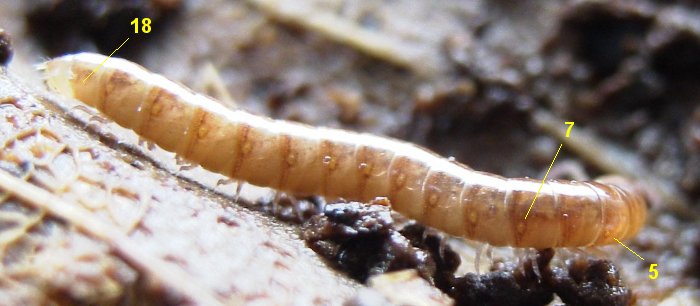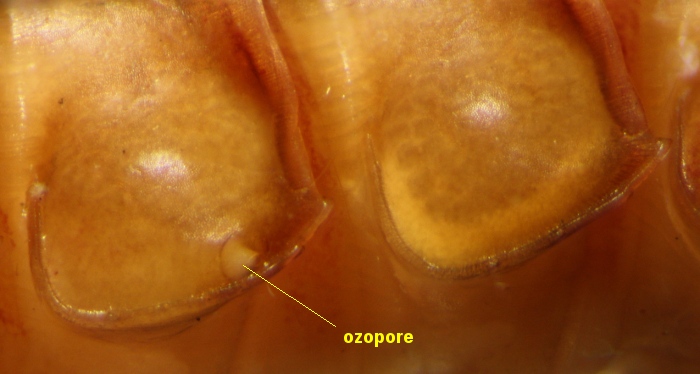Back to: sternites
Forward to: spiracles
Ozopores
Most Polydesmida protect themselves from predators by secreting noxious chemicals. The chemicals are manufactured in special glands called ozadenes and are released through openings called ozopores.
Polydesmidan ozadenes mainly produce hydrogen cyanide gas, by the breakdown (just before release) of mandelonitrile, mandelonitrile benzoate or benzoyl nitrile (Shear et al. 2007, Makarov et al. 2010). Some Polydesmida secrete less toxic, but equally powerful repellents, such as p-cresol (Shear et al. 2007), nitroethenylbenzenes (Kuwahara et al. 2002) and acyclic vinyl ketones (Jones et al. 2017)
In the majority of Polydesmida, the ozopores are located as shown below. There is one ozopore on each side of rings 5, 7, 9, 10, 12, 13 and 15-19 (H+20 species) or 5, 7, 9, 10, 12, 13 and 15-18 (H+19 species). This arrangement is called the normal pore formula.

Normal pore formula (H+20 species). Ozopores shown as blue dots.
There are variations on this arrangement. Campodesmidae, for example, only have ozopores on rings 5 and 7, and some Sphaeriodesmidae have no ozopores at all. In other Polydesmida, some or all of the 'missing' ozopores on rings 6, 8, 11 and 14 are present. In a group of H+19 Tasmanian genera in the suborder Dalodesmidea, the pore formula is 5, 7-18 (see image below).

Paredrodesmus taurulus (family uncertain), Tasmania. About 10 mm long.
Variations can occur within a genus. The tiny H+20 Prosopodesmus jacobsoni (Haplodesmidae) has the pore formula 5, 7-19, while P. panporus has 5-18 in its H+19 males and 5-19 in its H+20 females. In Australia, 28 of the 29 known species in the H+20 genus Lissodesmus (Dalodesmidae) have the normal pore formula, while L. perporosus has 5, 7, 9-19.
The size and position of ozopores also vary. In species with wide paranota, the ozopores are usually near the outer paranotal margin (see below), and are sometimes surrounded by a halo of thickened cuticle called a peritreme (plural peritremata). In some species the ozopore opens dorsal to the base of a low-set paranotum, and in Dorsoporus barroensis (Dorsoporidae) from Panama the ozopores are not far from the dorsal midline.

Left lateral view of paranota on rings 7 (left) and 8 (right)
of Lissodesmus perporosus (Dalodesmidae), Tasmania.
Although ozopores usually open flush with the body surface (below, left), in some Polydesmida they open on short columns called porosteles (below, right).

(Left) Ozopore of Paredrodesmus bicalcar (see image of live P. taurulus above), Tasmania.
(Right) Side view of porostele of Eutrichodesmus armatocaudatus (Haplodesmidae), Vietnam.
E. armatocaudatus image courtesy S.I. Golovatch. Scale bars = 0.01 mm.
Jones, T.H., Guthrie, D.M., Hogan, C.T., Robinson, D.J., Mesibov, R., Shear, W.A., Spande, T.F. and Saporito, R.A. 2018. The chemistry of some dalodesmidean millipedes from Tasmania (Diplopoda, Polydesmida). Journal of Natural Products 81: 171-177. [DOI link
Kuwahara, Y., Omura, H. and Tanabe, T. 2002. 2-Nitroethenylbenzenes as natural products in defensive secretions. Naturwissenschaften 89: 308-310.
Makarov, S.E., Ćurčić, B.P.M., Tešević, V.V., Jadranin, M.B., Vujisić, L.V., Ćurčić, S.B., Mandić, B.M., Sekulić, T.L. and Mitić, B.M. 2010. Defensive secretions in three species of polydesmids (Diplopoda, Polydesmida, Polydesmidae). Journal of Chemical Ecology 36: 978-982.
Shear, W.A., Jones, T.H. and Miras, H.M. 2007. A possible phylogenetic signal in milliped chemical defenses: The polydesmidan milliped Leonardesmus injucundus Shelley and Shear secretes p-cresol and lacks a cyanogenic defense (Diplopoda, Polydesmida, Nearctodesmidae). Biochemical Systematics and Ecology 35: 838-842.
Back to: sternites
Forward to: spiracles
